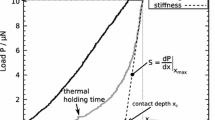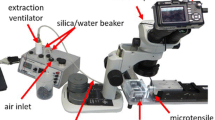Abstract
The factors affecting mechano-sorptive creep of wood and paper have been investigated for a long time. It has also been argued that single wood fibres do not exhibit mechano-sorptive creep and that the reasons for the accelerated creep under moisture cycling conditions instead are related to the bonds between the fibres. In order to examine the relevance of this argument, measurements on single pulp fibres of different composition were performed in tension, and the mechano-sorptive creep was compared to that of papers made from the same source of pulp fibres. All fibres tested were found to exhibit an increased creep rate during moisture cycling as compared to constant humidity conditions. Thus, pulp fibres show mechano-sorptive creep and in this sense behave similar to solid wood or paper products made thereof. A linear relation between the creep strain rate during cyclic humidity and the creep strain rate at a constant humidity was also noted for both fibres and paper. This relation was not affected by changes in hemicelluloses content or composition, neither for fibres nor for papers made of these fibres. However, in all cases, papers showed a much higher mechano-sorptive creep than the corresponding fibres they were made of.









Similar content being viewed by others
References
Alfthan J (2004) Micro-mechanically based modeling of mechano-sorptive creep in paper. Solid Mechanics. PhD thesis, solid mechanics, KTH, Stockholm
Bazant ZP (1985) Constitutive equation of wood at variable humidity and temperature. Wood Sci Technol 19:159–177
Bergander A, Salmén L (2002) Cell wall properties and their effects on the mechanical properties of fibers. J Mat Sci 37(1):151–156
Bethe E (1969) Strength properties of construction wood stored under changing climates and mechanical load. Holz Roh-Werkstoff 27(8):291–303
Burgert I, Gierlinger N, Zimmermann T (2005) Properties of chemically and mechanically isolated fibres of spruce (Picea abies [L.] Karst.) Part 1: structural and chemical characterization. Holzforschung 59:240–246
Coffin DW (2005) The creep response of paper. In: I’Anson SJ (ed) Advances in paper science and technology. Lancashire, UK, FRC, pp 651–747
DeMaio A, Patterson T (2006) Influence of bonding on the tensile creep behavior of paper in a cyclic humidity environment. Mech Time Depend Mater 10:17–33
Dong F, Olsson A-M, Salmén L (2010) Fibre morphological effects on mechano-sorptive creep. Wood Sci Technol 44(3):475–483
Eriksson L, Norén B (1965) The effect of moisture changes on the deformation of wood with tension in fibre direction. Holz Roh-Werkstoff 23(5):201–209
Fioravanti M, Sodini N, Navi P (2006) Investigation of the influence of hemicelluloses on time dependent behaviour of wood. In: Fioravanti M, Macchioni N (eds) Integrated approach to wood structure, behaviour and applications, ESWM, COST action E35, Florence pp 187–191
Gibson EJ (1965) Creep of wood: role of water and effect of a changing moisture content. Nature 206(4980):213–215
Habeger CC, Coffin DW (2000) The role of stress concentrations in accelerated creep and sorption-induced physical aging. J Pulp Paper Sci 26(4):145–157
Habeger CC, Coffin DW, Hojjatie B (2001) Influence of humidity cycling parameters on the moisture-accelerated creep of polymeric fibers. J Polym Sci Part B Polym Phys 39:2048–2062
Haslach HW (1994) The mechanics of moisture accelerated tensile creep in paper. Tappi 77(10):179–186
Navi P, Stanzl-Tschegg SE (2009) Micromechanics of creep and relaxation pf wood. A review. Holzforschung 63(2):1
Navi P, Pittet V, Plummer CJG (2002) Transient moisture effects on wood creep. Wood Sci Technol 36:447–462
Olsson A-M, Salmén L, Eder M, Burgert I (2007) Mechano-sorptive creep in wood fibres. Wood Sci Technol 41(1):59–67
Padanyi ZV (1993) Physical aging and glass transition: effects on the mechanical properties of paper and board. In: Baker CF (ed) Products of papermaking. Leatherhead, U.K., Pira International, pp 521–545
Sedlachek KM (1995) The effect of hemicelluloses and cyclic humidity on the creep of single fibers. PhD thesis Institute of paper Science and technology. Atlanta, Univ. Georgia Tech
Sedlachek KM, Ellis RL (1994) The effect of cyclic humidity on the creep of single fibers of Southern pine. In: Laufenberg TL, Fellers C (eds) Moisture-induced creep behaviour of paper and board. STFI USDA, Stockholm, pp 22–49
Söremark C, Fellers C (1993) Mechano-sorptive creep and hygroexpansion of corrugated board in bending. J Pulp Pap Sci 19(1):J19–J26
Wang S (1996) Delignification and bleaching with peracids. PhD thesis, Department of Wood and Paper Science. Raleigh, North Carolina State University
Author information
Authors and Affiliations
Corresponding author
Rights and permissions
About this article
Cite this article
Olsson, AM., Salmén, L. Mechano-sorptive creep in pulp fibres and paper. Wood Sci Technol 48, 569–580 (2014). https://doi.org/10.1007/s00226-014-0624-5
Received:
Published:
Issue Date:
DOI: https://doi.org/10.1007/s00226-014-0624-5




